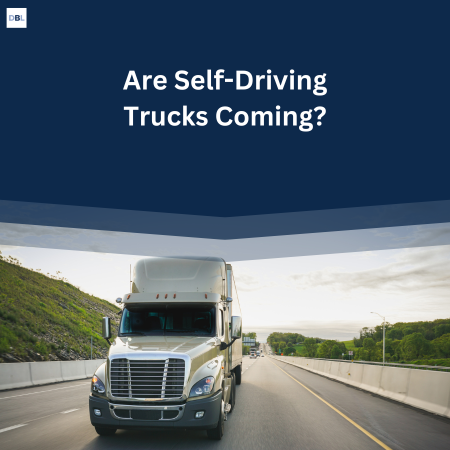
Recent developments in sensors and artificial intelligence have brought self-driving motor vehicles closer to reality on American highways. Many new passenger vehicles already have “driver assist” capabilities, and fully automated vehicles are under development. In the U.S. trucking industry, multiple companies have plans to put thousands of self-driving tractor-trailers and other large trucks on the road in the next few years.
Late this year, Aurora Innovation plans to start hauling freight on Interstate 45 between the Dallas and Houston areas of Texas with 20 driverless trucks, the Associated Press reported. Kodiak Robotics introduced what it called the world’s first driverless-ready semi-truck designed for scaled deployment in January and said it too will operate driverless trucks between Dallas and Houston this year, according to Transport Topics.
Further, autonomous trucking company Gatik is working with Goodyear Tire & Rubber Co. to develop self-driving medium-duty box trucks to become part of its self-driving fleet in the U.S. and Canada. Also, in August 2023, Kodiak Robotics and travel center operator Pilot Co. opened Georgia’s first autonomous truck terminal 30 miles west of Atlanta.
“Within three or four years, Aurora and its competitors expect to put thousands such self-driving trucks on America’s public freeways,” the AP says. “The goal is for the trucks, which can run nearly around the clock without any breaks, to speed the flow of goods, accelerating delivery times and perhaps lowering costs. They’ll travel short distances on secondary roads, too.”
Self-driving trucks are coming. We can expect the deployment of autonomous trucks in waves as technology improves and cost-effectiveness is assessed. Industry leaders say safety is the most important goal, given that most truck accidents can be tied to human choice or error.
In Lancaster, S.C., David Blackwell, founder and truck accident lawyer at David Blackwell Law, will continue to assist South Carolinians who have been injured in truck accidents regardless of how these new trucks are operated. We recover compensation for the injured when truck drivers, their trucks, and/or companies that deploy large trucks are responsible for accidents.
Self-Driving But Not Driverless
The U.S. trucking industry continues to face a truck driver shortage, with estimates suggesting that the industry is approximately 50,000 qualified drivers short of what’s needed. Reducing “long-haul” responsibilities is one of the aims of automation meant to make the job more attractive to prospective drivers.
A Library of Congress research guide says that fully autonomous trucks — including truck platoons of two or more trucks in which all trucks have a driver, but only the driver of the lead truck has full control of the vehicle — are expected to appear on highways by 2027.
Autonomous trucks are controlled from other sources such as satellites and advanced GPS. Some trucks already provide a semi-autonomous mode of operation, in which the unmanned system and/or a human operator control it through various levels of human-robot interaction. In the fully autonomous mode of operation, the unmanned system is expected to complete delivery or pickup assignments without human intervention.
In the teleoperation mode of operating a truck, a human operator uses video feedback and/or other sensory feedback to either directly control the truck or continuously assign tasks while away from the vehicle via a tethered or radio-linked control device.
Finally, in the remote-control mode of operation, the human operator, without benefit of video or other sensory feedback, directly controls the actuators of a truck’s unmanned system on a continuous basis from a separate location via a tethered or radio-linked control device using visual line-of-sight cues.
Will Autonomous Truck Driving Avoid Truck Accidents?
Phil Koopman, a professor at Carnegie Mellon University who studies vehicle automation safety, told the AP that self-driving trucks can theoretically be safer than human-driven ones because they lack drivers who might become distracted or impaired. But he cautioned that the vehicles’ computers inevitably will make errors. Just how the trucks will fare in real-world situations, he said, will depend on the quality of their safety engineering.
No federal regulations specifically cover autonomous vehicles. Most states have no such regulations, either. Koopman said the automated-vehicle industry has persuaded many states to bar local governments from enacting regulations.
Safety advocates warn that with almost no federal regulation, it will be mainly up to the self-driving truck companies themselves to determine when the semis are safe enough to operate without humans on board.
In May 2022, a self-driving truck operated by Waymo LLC, formerly known as the Google Self-Driving Car Project, was run off Interstate 45 approximately 35 miles south of Dallas by another trucker in a hit-and-run incident. The human safety operator inside the autonomous semi sustained “moderate” injuries, according to Techcrunch.com.
In February 2022, a similar self-driving Waymo Peterbilt 579 traveling southbound on Interstate 10 near Sacaton, Arizona, was struck by a box truck traveling in the adjacent lane. The Waymo vehicle was going 50 mph in a 75 mph zone.
More than a year later, Waymo suspended its driverless truck tests in Texas, opting to “focus [its] efforts and investment on ride-hailing,” instead.
In June 2021, the National Highway Traffic Safety Administration (NHTSA) required manufacturers and operators to report crashes involving all types of vehicles equipped with Level 3-5 SAE Automated Driving Systems (ADS). As of May 15, 2022, 25 entities had reported 130 crashes involving ADS-equipped vehicles. Three collisions involved heavy trucks. According to a separate NHTSA report, 12 entities had submitted incident reports for 392 crashes involving Level 2 ADAS-equipped vehicles. Thirteen of those crashes involved heavy trucks.
As with any new technology, failures are inevitable. Law.com published a 1,500-word article in October 2023 advising personal injury lawyers to expect and prepare for accident cases involving self-driving semi-trucks.
What Happens If Someone Gets Injured in a Collision with a Self-Driving Truck?
If you happen to be injured in an accident that involves an autonomous vehicle, you may be entitled to compensation if the accident was caused by a technical failure related to the vehicle or by another party’s negligence. If it occurs in South Carolina, you should contact David Blackwell, a reputable truck accident lawyer at David Blackwell Law.
If you are able, photograph any markings on a semi-truck at the accident scene that may identify its owners or operators. You should also ask law enforcement officials who respond to the accident how to obtain a copy of their report and follow up on those instructions as soon as possible. This will identify the driver and vehicle’s registration. In the meantime, have your injuries examined and follow all doctors’ orders for medical treatment.
Get in Touch with Our Truck Accident Lawyer for Help
 Injured in an accident caused by a semi-truck in South Carolina? David Blackwell, an experienced Lancaster truck accident lawyer, can help you recover compensation for your injuries and to rebuild your life. Contact David Blackwell Law today for a free, no-obligation consultation about how we can help you obtain the financial recovery you deserve.
Injured in an accident caused by a semi-truck in South Carolina? David Blackwell, an experienced Lancaster truck accident lawyer, can help you recover compensation for your injuries and to rebuild your life. Contact David Blackwell Law today for a free, no-obligation consultation about how we can help you obtain the financial recovery you deserve.
